Mastering Picture Hanging: Expert Tips and Techniques
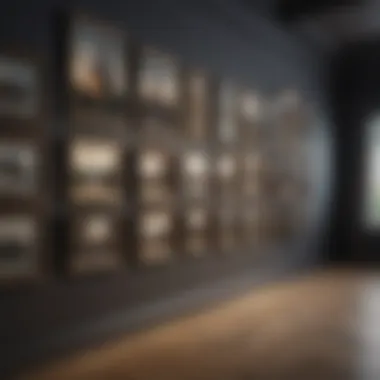
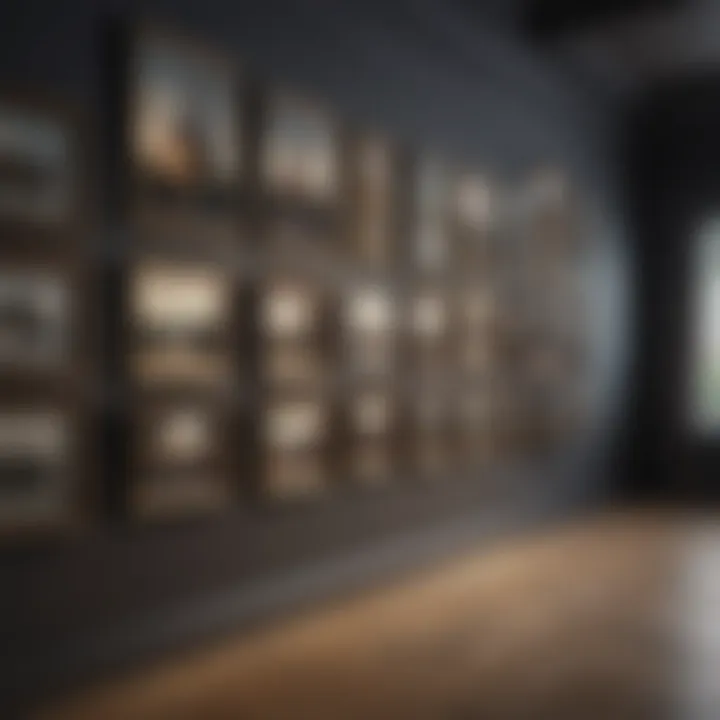
Intro
Hanging pictures is more than a simple act of decor. It involves understanding space, art, and personal expression. The way a room is arranged presents an opportunity to enhance its ambiance through well-placed artworks. To achieve an aesthetic balance, several factors come into play, including room proportions, furniture alignment, artistic choices, and lighting effects. This guide aims to navigate these aspects systematically, offering practical insights into creating cohesive displays.
When one considers hanging a picture, the goal is often to evoke emotions or highlight certain elements of a room. Selecting the right location can turn blank walls into galleries, while incorrect placements may lead to visual chaos. Therefore, careful planning and consideration of each element are crucial to successful picture hanging.
This guide serves as a blueprint for anyone seeking to transform their spaces with art. By addressing key practices and potential pitfalls, it will cater to the needs of home decorators, interior design enthusiasts, and art lovers alike.
Understanding the Basics of Picture Hanging
Picture hanging is both an art and a skilled practice that plays a significant role in interior design. Understanding the basics serves as a foundation for creating an engaging visual environment. The arrangement of artwork can affect overall room aesthetics, influence mood, and even change perceptions of space. When art is presented thoughtfully, it enhances the ambiance and serves as a focal point in any room. This guide aims to equip readers with essential insights on picture hanging to ensure an artful display.
Historical Context of Wall Art Display
The practice of displaying art on walls dates back to ancient civilizations. Historically, wall art has been used as a means of communication, storytelling, and self-expression. For instance, cave paintings in prehistoric times showcased humanity’s earliest attempts at recording experiences and beliefs. As societies evolved, so too did the methods and significance of visual art.
During the Renaissance, the importance of art grew substantially, and proper placement became crucial. Artists and patrons would use walls to demonstrate wealth and taste. This period introduced concepts such as symmetry and perspective in arrangement, further elevating the experience of viewing art. Such historical influences remain relevant today, as modern-day practices of displaying art continue to reflect these historic ideologies.
Significance of Proper Placement
Proper placement in picture hanging cannot be understated. It directly impacts how viewers engage with the artwork. The three vital elements to consider are height, accessibility, and surroundings. Interestingly, art that is hung at eye level tends to be more appreciated. This height allows for easy viewing, making it a crucial aspect of the overall presentation.
Furthermore, the surrounding elements should complement the artwork. For example, the choice of color for the wall can either enhance or detract from the piece. Hanging art too high or too low can lead to a disconnect between the piece and the viewer, making it imperative to find the right balance.
Careful consideration of placement contributes significantly to the overall visual harmony of a space. As a result, mastering the basics of picture hanging regarding placement helps create a cohesive and aesthetically pleasing environment.
Factors to Consider When Choosing a Location
Choosing the right location to hang pictures is a crucial aspect of achieving a visually appealing environment. This section explores several key elements. These considerations not only enhance the aesthetic value but also ensure that the artwork complements the overall space.
Room Dimensions and Wall Space
The dimensions of your room significantly influence where you should hang your pictures. In larger rooms, expansive wall areas offer flexibility for displaying larger pieces or several smaller ones. These provide a chance to create an impressive focal point. Conversely, in a smaller room, the wall space might be limited. Here, selecting one or two key pieces enhances the area without feeling crowded.
When assessing wall space, consider the height and width available. A large, empty wall may seem inviting but requires careful planning. If you hang a picture that is too small, it might look insignificant. Instead, aim for larger art pieces or arrangements that draw the eye without overwhelming the space.
"The scale of the artwork should complement the surrounding environment, not compete with it."
Furniture Arrangement and Scale
Furniture influences picture placement directly. Ensure that the artwork aligns well with the furniture arrangement. Hanging pictures too low or too high can disrupt the flow of the room. For example, if you have a sofa, the artwork should ideally hang at eye level for those seated. This creates a connection between the wall and the furniture.
Consider the scale as well. Large pieces of furniture can support bigger artworks, while delicate furniture pairs better with smaller pieces. Always pay attention to the proportions of both the art and the furniture. This synchroneity creates a more balanced visual experience.
Lighting Conditions and Effects
Lighting plays a vital role in how your pictures are perceived. Natural light can highlight colors and textures but can also cause fading over time. Hence, avoid placing valuable art pieces directly in sunlight. Instead, consider positioning them in areas where ambient light complements them.
Additionally, artificial lighting can dramatically enhance or detract from artwork. Spotlights can create dramatic effects, while softer, ambient lighting adds warmth. The type of light bulb can also affect the appearance of the colors; for instance, LED lights often display colors differently than incandescent bulbs. Therefore, it’s critical to assess how lighting will interact with your selected pictures before finalizing their position.
In summary, these factors are interlinked. By evaluating room dimensions, furniture placement, and lighting effects, one can choose optimal spots for picture hanging. This thoughtful approach ensures not just art appreciation but also elevates the overall aesthetic appeal of a space.

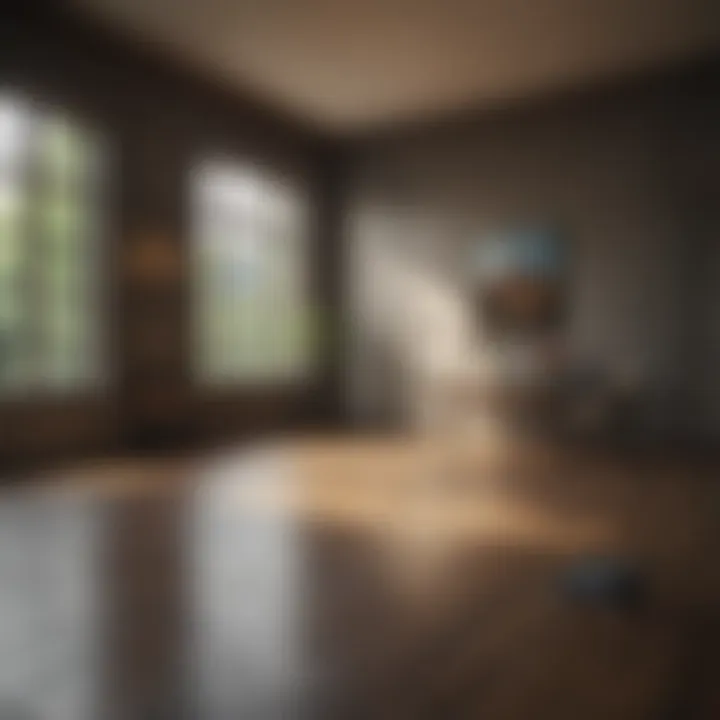
Techniques for Finding the Ideal Height
Finding the right height to hang pictures is essential for achieving a polished and aesthetically pleasing look. Proper height can directly affect how a viewer experiences the artwork. It can emphasize the subject of the piece or create a sense of balance in the room. Several factors contribute to determining the ideal height, including the type of artwork, the viewing distance, and the overall design of the space.
The Eye Level Principle
The eye level principle suggests that artwork should be hung around the average eye level for the most effective viewing experience. For most people, this falls between 57 to 60 inches from the floor. This guideline stems from studies in art galleries and museums, where it has been observed that paintings and photographs displayed at this height are most easily appreciated.
To apply this principle:
- Measure the height from the floor to your eyes when standing.
- Mark a point at this height on the wall.
- Ensure the center of your artwork aligns closely with this mark.
This technique considers that viewers come from diverse heights, yet aiming for the midpoint generally accommodates the majority.
Artistic Height Considerations
While the eye level principle is beneficial, there are artistic considerations that may lead you to adjust the height of your artwork. These adjustments are particularly relevant for unique installations.
- Type of Artwork: Large, bold pieces can draw attention that warrants a more prominent position, slightly above standard eye level. On the other hand, small, intricate pieces might be better suited to a lower height, inviting closer inspection.
- Room Functionality: In spaces with specific activities, such as living rooms or dining areas, consider how the art interacts with furniture. For example, artworks above a sofa should initiate visual flow without overshadowing the furniture.
- Room Size and Proportions: In larger rooms, a higher placement can create a more dramatic effect, while smaller rooms may feel overwhelmed by art located too far above eye level. A good strategy is to maintain a proportional relationship between the size of the art and the wall it occupies.
Remember, aesthetic impact can often outweigh standard guidelines when it comes to art placement.
By thoughtfully applying both the eye level principle and artistic considerations, one can enhance not just the art itself but also the overall atmosphere of the room.
Types of Walls and Their Implications
Understanding wall types is crucial when deciding how to display artwork. Each type of wall presents unique challenges and opportunities that can greatly affect the aesthetic appeal of your space. Factors such as texture and color play significant roles in enhancing or detracting from the artwork.
Textured versus Smooth Surfaces
Textured walls offer a distinct character that can enhance or overpower your artwork. They have physical depth, which might create interesting shadows, yet this can also interfere with the visibility of the pieces you hang. When hanging on textured surfaces, it's best to use artwork with a robust frame. This helps to delineate the art from the wall and allows it to stand out more effectively.
Smooth walls traditionally provide a more modern, clean backdrop for artwork. They offer an unobstructed view and often reflect light better, enhancing color dynamics. With smooth surfaces, it is advisable to select lighter pieces or those with strong colors, so they resonate against the uniform backdrop.
In practical terms:
- Hanging Techniques: On textured walls, consider anchors or wall hooks that adapt to uneven surfaces. For smooth walls, adhesive strips or simple nails may suffice.
- Visual Impact: Ensure the artwork has enough contrast with the wall type to maintain its visual integrity.
Color Schemes and Contrast
Color schemes dramatically influence how art is perceived in a space. Selecting a color for your walls that complements your artwork can create a harmonious environment. On the other hand, colors that clash can draw attention away from the piece, leading to an unsettling visual experience.
When using bright or bold colors for the wall, the art might need to be equally vibrant to stand out. Conversely, neutral walls often allow for more diverse artwork choices. They provide a classic backdrop that lets the colors of the artwork itself pop. Understanding color theory can enhance this choice:
- Complementary Colors: Colors opposite each other on the color wheel will enhance each other’s brightness.
- Analogous Colors: Colors next to each other create a sense of tranquility but may cause the artwork to blend in too much.
The interaction between your wall color and your art can drastically affect the perception of both.
Selecting the right wall type and color scheme is not merely an immediate concern but impacts the ambiance and character of the entire room. Each element must align with the overall aesthetic goals to ensure a cohesive display.
Hanging Techniques and Tools
Understanding the various hanging techniques and tools is crucial for successful picture display. Using the right method ensures that artwork is securely mounted while achieving the desired visual effect. The choice of hardware affects both aesthetics and safety, ensuring pieces do not fall or tilt. Proper hanging can transform a room and enhance its overall feeling.
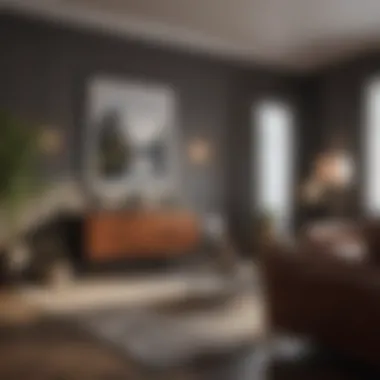
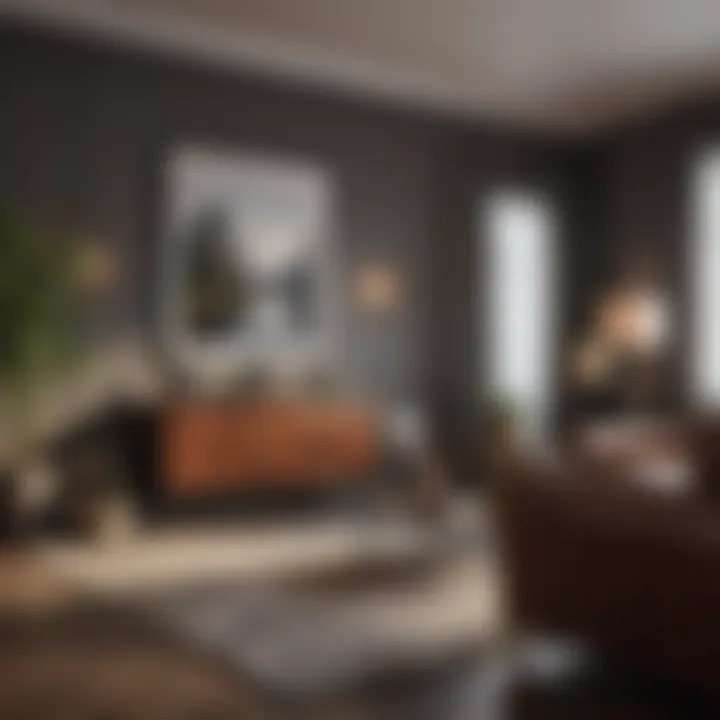
Different Types of Hanging Hardware
When it comes to hanging art, the variety of hardware available can be overwhelming. Here are the most common options:
- Nails and Picture Hooks: Simple and effective for lightweight frames. Ensure the nail fits securely into the wall and can hold the frame's weight.
- D-rings and Wire: This is standard for larger artworks. Attach D-rings to the back of the frame and use wire to create a flexible hanging method.
- Wall Anchors: For heavier pieces, wall anchors provide extra support. These are essential if mounting on drywall or plaster.
- Adhesive Strips: Perfect for renters or temporary displays. They hold lightweight frames but be aware of the removal process to avoid wall damage.
- French Cleats: A more advanced method, French cleats distribute weight evenly and allow for easy adjustment.
Selecting the right hardware depends largely on the weight and type of artwork being hung. Each option has unique characteristics that cater to different needs and spaces.
Preparation Steps Before Hanging
Preparation is key to a successful picture-hanging experience. Here are essential steps to follow:
- Choose the Right Location: Assess the wall space for the picture’s placement. Consider the view from different angles.
- Measure and Mark: Use a tape measure to determine the height and positioning. Mark lightly with a pencil where you will hang the piece.
- Check for Level: Ensure that your marks are level. A simple level tool can help with this task.
- Select Appropriate Hardware: Based on the frame’s weight and wall type, choose your hanging hardware wisely.
- Prepare the Wall: Clean the area to remove dust. For adhesive methods, ensure the wall is dry.
Proper preparation can save you time and effort later.
Taking the time to prepare ensures that the hanging process goes smoothly, leading to a professional-looking display. Proper planning contributes to a cohesive and pleasant aesthetic throughout the space.
Arranging Multiple Pictures
Arranging multiple pieces of art or photographs is a nuanced art in itself. This section delves into effective methods to create a visually appealing display that enhances any room. Understanding how to curate a collection can impact not just design aesthetics but also the emotional resonance of a space. It is crucial to keep in mind that proper arrangement respects both individual pieces and the overall environment.
Creating a Gallery Wall
A gallery wall allows a cohesive story to unfold through curated artworks. This method creates an engaging focal point. Start by selecting a theme; it could be color, subject, or mood. Collect images that align with this theme to ensure a unified look. Using different sizes can add character, but too much variety may confuse the viewer.
When laying out a gallery wall, consider these strategies:
- Lay It Out on the Floor First: This technique helps visualize spacing without committing to wall damage. Adjust arrangements until satisfied.
- Use the Rule of Thirds: Place your most significant piece at eye level, then surround this artwork with smaller pieces.
- Spacing is Key: Maintaining consistent gaps between frames is vital for unity. Aim for a distance of 2 to 5 inches, as this keeps the eye moving along the arrangement.
Creating a gallery wall is not just about aesthetics; it reflects personality. It showcases interests or moments significant to the individual or family, making it an ongoing conversation starter.
Balancing Size and Layout
Size and layout are fundamental components in arranging multiple pictures. As mentioned earlier, a gallery wall can feature a mix of small and large artworks, yet balance is crucial. Large pieces can dominate space, possibly overshadowing smaller pieces. To avoid this, it is important to distribute varying sizes evenly.
Here are some considerations for effective balance:
- Visual Weight: Heavier images need more space. Place them centrally or at lower positions.
- Foundational Layers: Use larger formats as a backdrop. Incorporate smaller images within this framework, creating a sense of depth while maintaining lightness.
- Color Coordination: Pair neutral colors alongside vivid displays to ensure that colors complement rather than compete.
Achieving harmony in size and layout amplifies the impact of each piece. Properly thought-out arrangements can turn a wall into a striking work of art, compelling visitors to appreciate the collective narrative presented through each image.
Utilizing Frames and Matting
Selecting the proper frames and matting is not merely a decorative choice; it plays a crucial role in elevating the overall presentation of art. Frames are the protective boundary that enhances visual interest, while mats add depth and a polished look. Both elements contribute significantly to the success of your picture hanging endeavors.
Choosing Frames that Compliment
Choosing the right frames requires considering the style and tone of both the artwork and the environment where it will be displayed. For instance, sleek, modern frames work well with minimalist art, while ornate frames can enhance classical pieces.
It's important to choose a frame that does not overshadow the art itself. Instead, it should accentuate its qualities. Here are some guidelines to help you choose:
- Material Matters: Frames can be wood, metal, or even acrylic. Each material brings its own texture and feel.
- Color Coordination: The color of the frame should harmonize with the colors in the artwork, as well as the surrounding walls. Shades that contrast with the wall color can create a striking appearance.
- Style Compatibility: Frames should align with the theme of your decor. A rustic frame might clash with a contemporary interior.
The essence of good framing is to ensure it substantiates the art, drawing attention without distraction.
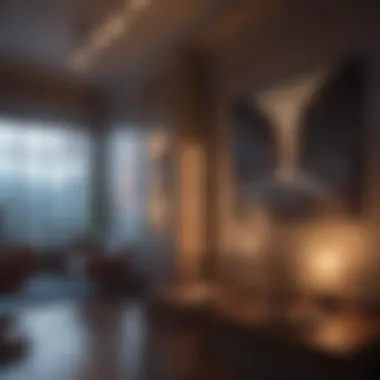
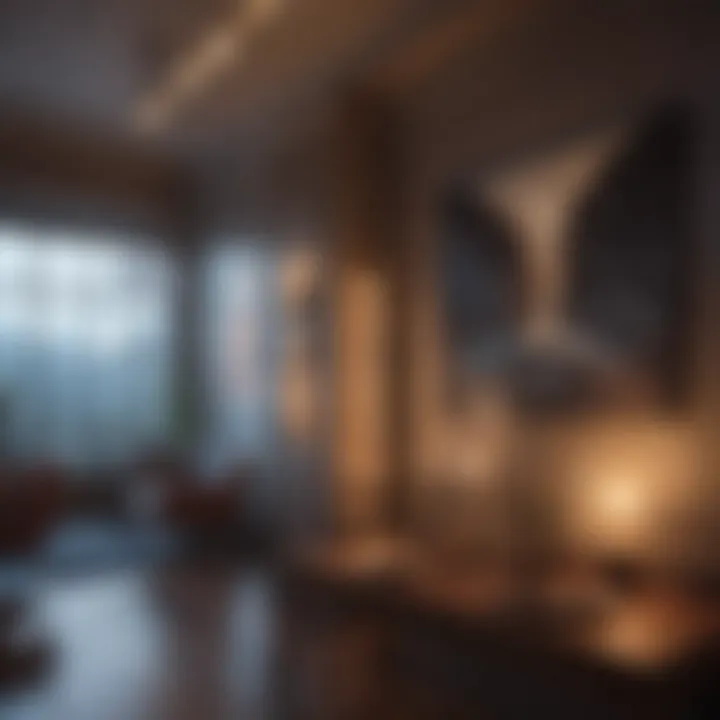
Matting Options and Their Impact
Matting serves several purposes besides aesthetic enhancement. It provides a visual breathing space around the artwork and also protects it from coming into direct contact with the glass. The choice of matting can significantly influence overall perception. Consider the following matting aspects:
- Color Selection: Neutral and light colors often work best, allowing artwork to stand out while still adding a touch of elegance. A darker mat can lend a dramatic effect.
- Width of Mat: A wider mat can create a more spacious look, making the art feel less confined. Narrow mats may work better in smaller compositions.
- Texture Variety: Different textures in matting can offer depth to the overall presentation. Consider linen, smooth, or even patterned mats to achieve varying effects.
"The right matting can pull the viewer’s focus towards the artwork, accentuating its most compelling features."
Maintaining Balance and Symmetry
Maintaining balance and symmetry in picture hanging is critical to achieving an aesthetically pleasing display. This principle applies to both single pieces of art and gallery walls, where multiple items are presented. When balance is achieved, the viewer's eye is naturally drawn across the arrangement without discomfort. If an arrangement feels heavy on one side, it can create a sense of unease.
The importance of balance stems from its role in visual organization. It helps create a cohesive look that ties together various elements in a space. When art pieces are well-balanced, they enhance the room's overall harmony, allowing other design features to shine without overshadowing them. Therefore, understanding how to distribute visual weight is crucial.
Visual Weight Distribution
Visual weight refers to the apparent heaviness of an object, influenced by size, color, and detail. Lighter colors and smaller pieces weigh less visually, while darker colors and larger pieces seem heavier. When arranging artwork, consider the following tips for effective visual weight distribution:
- Size: Mix different sizes of artwork to create interest. Larger artworks can act as anchors, while smaller pieces can complement them.
- Color: Darker frames or images can draw more attention than lighter backgrounds. Adjust the placement to balance these visually.
- Detail: Highly detailed pieces command more attention, while simpler designs may recede into the background.
Achieving visual weight balance involves placing heavier pieces lower or in the center, with lighter ones positioned higher or further to the sides. This helps to create a centralized focal point that feels stable and organized.
Achieving Harmony in Design
Harmony in design is achieved when all elements work together to create a unified look. It entails not only the arrangement of the pictures but also how they fit with the surrounding decor. To achieve harmony in your picture hanging:
- Consider the Rest of the Room: Look at existing furniture and decor. The artwork should complement the overall style—be it modern, rustic, classic, or eclectic.
- Consistent Frames and Matting: Using similar frames can create a cohesive look, while varying mats can add depth and interest. Select frames that share a common color or finish.
- Spacing: Ensure consistent spacing between frames. Each piece deserves attention, so apply spacing that allows for individual appreciation without crowding.
"A well-designed arrangement draws attention, but good balance keeps it."
Common Mistakes to Avoid
Understanding the common mistakes in picture hanging is essential for achieving an aesthetically pleasing display. Many individuals overlook these pitfalls, resulting in an unbalanced or chaotic system of artwork presentation. Recognizing these errors can improve the overall appearance of a space significantly. The importance of this section is twofold. First, it helps foster a more deliberate approach to art placement. Second, it minimizes the risk of making uninformed decisions that can detract from the intended visual experience. In this way, careful consideration can transform a simple wall into an elegant gallery.
Overcrowding the Space
Overcrowding a wall with pictures is a frequent misstep. When multiple pieces of art are placed too closely together, it creates visual clutter. This can overwhelm the eye, distracting from the beauty of individual pieces. To prevent this, it's recommended to leave adequate spacing between each artwork. An effective rule of thumb is to maintain a distance of about 2 to 5 inches between frames, depending on their size.
Additionally, consider the scale of the artwork in relation to the wall itself. Large pieces can stand alone as focal points, while smaller items may need to be grouped with others to avoid isolation on an expansive wall. Planning the arrangement on the floor before committing to wall space can also provide clarity. Using painter's tape as a boundary to visualize placement can be an effective technique to help understand how the entire composition will look once completed.
Ignoring the Surrounding Context
Another significant oversight involves disregarding the surrounding context of the artwork. This includes elements like furniture arrangement, wall color, and room function. Pictures should complement their environment rather than clash with it. For instance, if a wall is painted in a bold color, art with similar tones might merge into the background instead of standing out.
The function of the room must also inform placement. In a peaceful bedroom, for example, calming pieces may be more appropriate than energetic artwork. Furthermore, aligning the artwork with furniture, such as ensuring that a picture aligns with a sofa or console table, creates a cohesive and harmonious design.
Finding balance is key. Each element in the room—art, furniture, and even structural components—must work together to achieve an inviting atmosphere. By acknowledging the context, one can avoid art placements that detract from the overall intended ambiance.
Epilogue
In summing up the comprehensiveness of this guide on picture hanging, it is essential to acknowledge the myriad of factors that contribute to an aesthetically pleasing display. This article has offered insights into the historical context and significance of wall art, laying a foundation for understanding its role in interior design.
Evaluating elements such as room dimensions, furniture arrangements, and lighting conditions is pivotal. These factors not only dictate where to position art, but they also define the emotional and psychological impact of the artwork on the viewer. The techniques discussed for determining ideal height, as well as the implications of different wall types, ensure that readers can make informed decisions that enhance their spaces.
Moreover, effective organization and maintenance of balance and symmetry are crucial for creating harmony within the decor. Avoiding common mistakes like overcrowding or ignoring the surrounding context is imperative to prevent a cluttered feel that detracts from the intended visual impact.
By focussing on these valuable considerations, readers can create displays that are not only visually engaging but also tailored to their unique environments. Ultimately, the art of picture hanging transcends mere placement—it's about cultivating an atmosphere that resonates personally while also making a statement.
"The right artwork, displayed correctly, can transform a space, adding depth and character."















